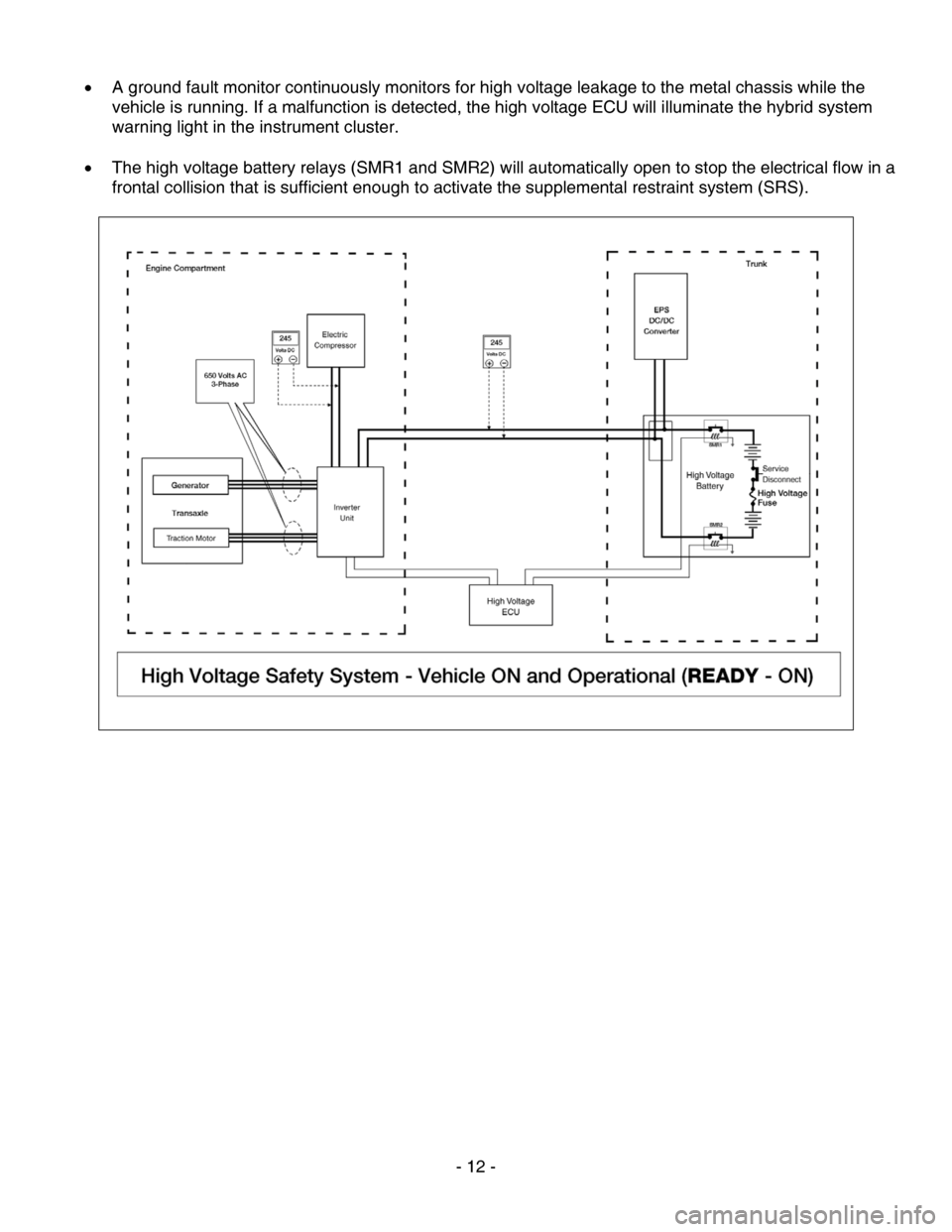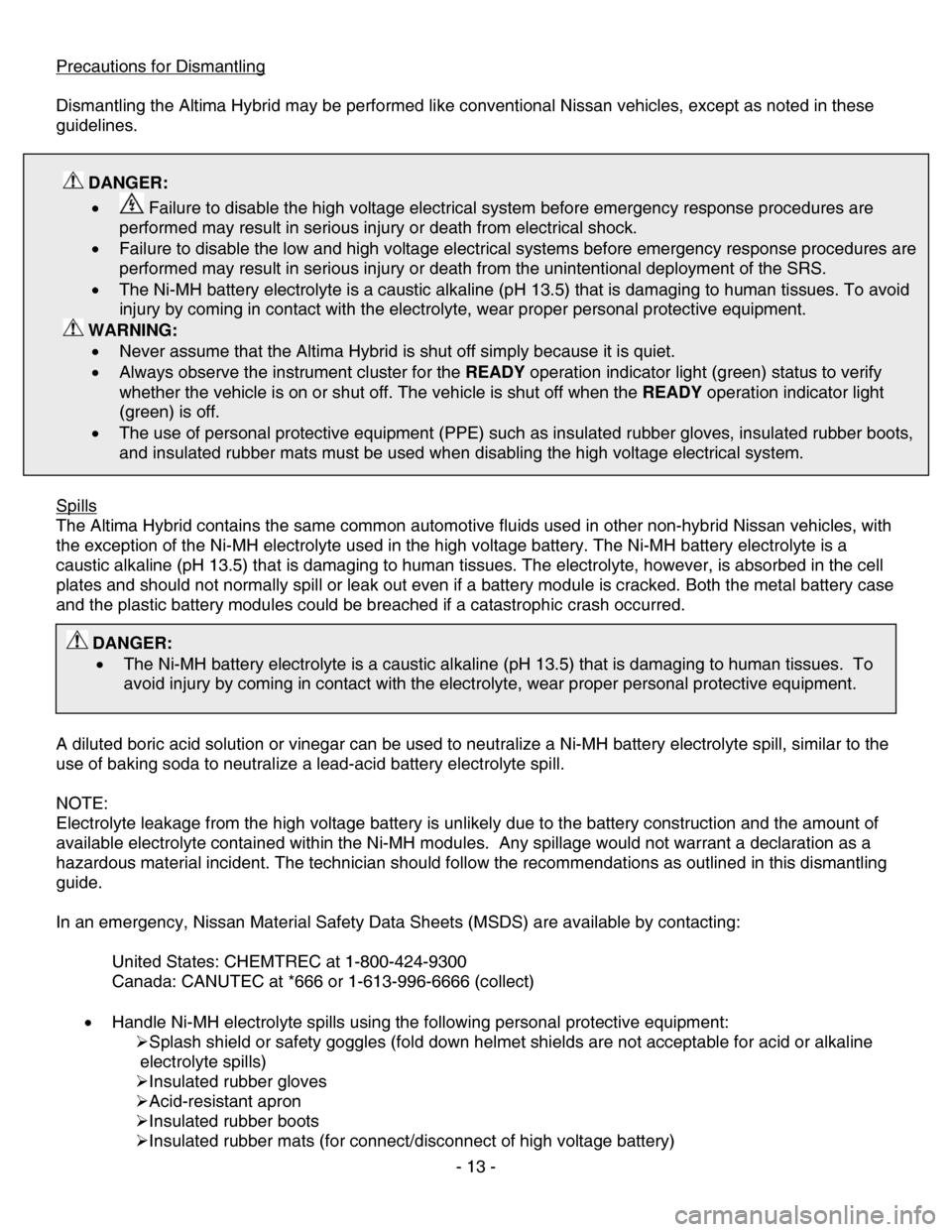light NISSAN ALTIMA HYBRID 2010 L32A / 4.G Dismantling Guide
[x] Cancel search | Manufacturer: NISSAN, Model Year: 2010, Model line: ALTIMA HYBRID, Model: NISSAN ALTIMA HYBRID 2010 L32A / 4.GPages: 23, PDF Size: 3.09 MB
Page 4 of 23

- 4 -
About the Nissan Altima Hybrid
There are two power sources stored on board that are used to drive the vehicle:
• Gasoline is stored in a fuel tank and is used to supply the gasoline engine.
• Electricity is stored in a high voltage battery and is used to power the traction motor.
The result of combining these two power sources is improved fuel economy and reduced emissions. The
gasoline engine also powers an electric generator to recharge the high voltage battery; unlike an entirely
electric vehicle, the Altima Hybrid never needs to be recharged from an external electric power source.
Depending on the driving conditions, one or both sources are used to drive the vehicle. The following
information explains how the Altima Hybrid operates in various driving modes:
1. During light acceleration at low speeds, the vehicle is driven by the traction motor. The gasoline engine
is shut off.
2. During normal driving, the vehicle is driven mainly by the gasoline engine. The gasoline engine also
powers the generator to recharge the high voltage battery.
3. During full acceleration, such as climbing a hill, both the gasoline engine and the traction motor drive
the vehicle.
4. During deceleration, such as when braking, the vehicle converts kinetic energy from the front wheels to
electricity that will recharge the high voltage battery.
5. While the vehicle is stopped, such as at a stoplight, both the gasoline engine and the traction motor are
off, however the vehicle remains operational.
Page 12 of 23

• A ground fault monitor continuously monitors for high voltage leakage to the metal chassis while the
vehicle is running. If a malfunction is detected, the high voltage ECU will illuminate the hybrid system
warning light in the instrument cluster.
• The high voltage battery relays (SMR1 and SMR2) will automatically open to stop the electrical flow in a
frontal collision that is sufficient enough to activate the supplemental restraint system (SRS).
- 12 -
Page 13 of 23

Precautions for Dismantling
Dismantling the Altima Hybrid may be performed like conventional Nissan vehicles, except as noted in these
guidelines.
DANGER:
•
Failure to disable the high voltage electrical system before emergency response procedures are
performed may result in serious injury or death from electrical shock.
• Failure to disable the low and high voltage electrical systems before emergency response procedures are
performed may result in serious injury or death from the unintentional deployment of the SRS.
• The Ni-MH battery electrolyte is a caustic alkaline (p H 13.5) that is damaging to human tissues. To avoid
injury by coming in contact with the electrolyte, wear proper personal protective equipment.
WARNING:
• Never assume that the Altima Hybrid is shut off simply because it is quiet.
• Always observe the instrument cluster for the READY operation indicator light (green) status to verify
whether the vehicle is on or shut off. The vehicle is shut off when the READY operation indicator light
(green) is off.
• The use of personal protective equipment (PPE) such as insulated rubber gloves, insulated rubber boots,
and insulated rubber mats must be used when disabling the high voltage electrical system.
Spills
The Altima Hybrid contains the same common automotive fluids used in other non-hybrid Nissan vehicles, with
the exception of the Ni-MH electrolyte used in the high voltage battery. The Ni-MH battery electrolyte is a
caustic alkaline (pH 13.5) that is damaging to human tissues. The electrolyte, however, is absorbed in the cell
plates and should not normally spill or leak out even if a battery module is cracked. Both the metal battery case
and the plastic battery modules could be breached if a catastrophic crash occurred.
DANGER:
• The Ni-MH battery electrolyte is a caustic alkaline (pH 13.5) that is damaging to human tissues. To
avoid injury by coming in contact with the electrolyte, wear proper personal protective equipment.
A diluted boric acid solution or vinegar can be used to neutralize a Ni-MH battery electrolyte spill, similar to the
use of baking soda to neutralize a lead-acid battery electrolyte spill.
NOTE:
Electrolyte leakage from the high voltage battery is unlikely due to the battery construction and the amount of
available electrolyte contained within the Ni-MH modules. Any spillage would not warrant a declaration as a
hazardous material incident. The technician should follow the recommendations as outlined in this dismantling
guide.
In an emergency, Nissan Material Safety Data Sheets (MSDS) are available by contacting:
United States: CHEMTREC at 1-800-424-9300
Canada: CANUTEC at *666 or 1-613-996-6666 (collect)
• Handle Ni-MH electrolyte spills using the following personal protective equipment:
�¾Splash shield or safety goggles (fold down helmet shields are not acceptable for acid or alkaline
electrolyte spills)
�¾ Insulated rubber gloves
�¾ Acid-resistant apron
�¾ Insulated rubber boots
�¾ Insulated rubber mats (for connect/disconnect of high voltage battery)
- 13 -